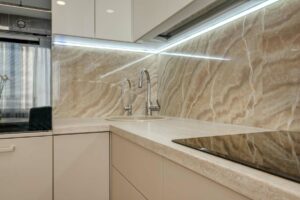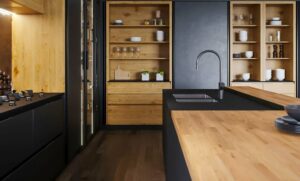Remodeling your kitchen using eco-friendly materials is one of the best ways to reduce your environmental impact. With sustainable options now available for nearly every element of kitchen design, going green no longer means compromising on functionality or aesthetics.
In this comprehensive guide, we will explore the array of eco-friendly countertops, cabinets, backsplashes, floors and more now on the market.
We’ll cover everything from the benefits of selecting sustainable materials to costs, maintenance, and sourcing to help you make informed decisions for your next kitchen refresh.
Why Choose Sustainable Kitchen Materials?

Opting for eco-friendly kitchen materials comes with many compelling benefits:
Reduce Environmental Impact
- Manufacturing traditional building materials like concrete and plastics generates significant carbon emissions. Selecting sustainable alternatives is better for the planet at large.
- Transportation emissions are also lower with locally sourced, natural materials.
- Eco-friendly kitchens support the circular economy by utilizing recycled content. This also reduces landfill contributions.
Healthier Indoor Air Quality
- Many eco-friendly materials like bamboo and cork naturally emit less VOC off-gassing and formaldehyde. This improves indoor air quality compared to carpets, vinyl, and engineered wood.
- Better indoor air means better health for your family. Studies show reduced asthma and allergy issues.
Enhanced Durability
- Contrary to popular belief, many green materials like metal and concrete are very durable. This increases the lifespan of your kitchen.
- Recycled glass countertops resist scratches, stains and heat better than natural stone.
- Sourcing local materials also reduces transport miles, resulting in less breakage.
Material Options
Eco-friendly kitchen materials span a range of natural products, recycled content, and responsibly-sourced options:
Bamboo
Made from a fast-growing grass, bamboo is renewable and antimicrobial. It is commonly used for cabinets and flooring.
Recycled glass
Crushed glass gets mixed with concrete or resin to create countertops and backsplashes.
Cork
Harvested from tree bark, cork is natural, renewable, and antimicrobial. Best used for flooring.
Concrete
Mix in recycled materials like glass for counters. Stylish modern look.
Reclaimed wood
Wood from old barns, factories and buildings gets a second life in cabinets and tables.
Let me know if you would like me to expand or modify anything in this first section before moving on to the next. Please provide any feedback so I can improve as I continue writing.
Key Areas to Use Eco-Friendly Materials
When undertaking a green kitchen remodel, some elements make more of an impact than others. We recommend focusing first on these key areas when selecting eco-friendly materials:
Countertops
Countertops see heavy use daily, so choosing sustainable materials here makes a significant difference. Top options include:
- Recycled glass countertops
- Bamboo countertops
- Concrete countertops
Cabinets
Cabinets make up the bulk of a large surface area in kitchens. Opting for greener materials reduces environmental footprint:
- Bamboo cabinets and doors
- Recycled wood cabinets
Backsplashes
While small in scale, backsplashes protect walls from daily spills and stains. Eco-friendly choices include:
- Recycled glass tile
- Recycled metal tile
Flooring
Kitchen floors endure heavy foot traffic. Consider sustainable options like:
- Cork flooring
- Bamboo floor ting
- Recycled tile
Dishware/Cutlery
Choose eco-friendly plates, cups water bottles, utensils and more to reduce daily waste:
- Bamboo dishware
- Recycled stainless steel cutlery
Countertop Materials

Countertops see a lot of action and take abuse over years of food storage, prep and spills. Choosing sustainable countertop materials that stand the test of time is crucial for green kitchens. Top eco-friendly options include:
Glass Countertops
Recycled glass countertops offer unique visual appeal and stand up well to heavy use. Here’s an overview:
- Composition: Crushed recycled glass gets combined with concrete or a bio-resin to create slabs
- Benefits: Stain- and scratch-resistant. Can withstand heat up to 450°F. Available in a wide variety of colors and patterns.
- Cost: $50-$100 per square foot installed, comparable to natural stone
- Maintenance: Clean with soapy water. Reseal every 1-2 years.
Pros ⚬ Extremely durable ⚬ Endless design possibilities
Cons ⚬ Heavy material requires cabinet reinforcement ⚬ Can chip if struck forcefully
Bamboo Countertops
For a greener alternative to traditional wood and plastic laminates, bamboo offers versatility at smaller budgets:
- Composition: Crafted from laminated bamboo sheets bonded with resins
- Benefits: Resistant to cuts, stains and heat. Naturally antimicrobial.
- Cost: $30-$60 per square foot installed
- Maintenance: Clean with soapy water. Reseal every 1-2 years.
Pros
⚬ Cost-effective eco-friendly option ⚬ Available in wide range of stains/finishes
Cons
⚬ Prone to scratches over time
⚬ Not heat-resistant above 350° F
Concrete Countertops
Concrete offers a stylish, indestructible option when made with recycled materials:
- Composition: Cement mixed with recycled glass or porcelain aggregates
- Benefits: Extremely durable and heatproof. Can mold into custom shapes. Stains wipe away easily.
- Cost: $100-$250 per square foot installed
- Maintenance: Seal annually. Avoid exposing to acids.
Pros
⚬ Withstands heavy impact ⚬ Customizable for unique designs
Cons
⚬ Chipping at edges and seams ⚬ Improper sealing can stain
Let me know if you would like me to expand or modify anything in this section on eco-friendly countertop options before I continue. Please provide any feedback so I can improve.
Eco-Friendly Cabinet Options
Kitchen cabinets make up a significant portion of most kitchens’ surface area. Choosing sustainable cabinets materials helps lower the overall environmental impact. Top eco-friendly options include:
Bamboo Cabinets and Doors
Bamboo has emerged as a versatile green alternative to traditional hardwoods:
- Composition: Bamboo sheets laminated into sturdy cabinet boxes and doors
- Benefits: Highly resistant to moisture and scratches. Naturally antimicrobial properties. Available in a wide variety of stains and finishes to fit any style.
- Cost: Comparable to mid-range wood cabinets, around $7,000 – $10,000 fully installed.
- Maintenance: Clean with mild soap and water. Reseal every 1-2 years.
Pros ⚬ Renewable and sustainable material ⚬ Antimicrobial properties ⚬ Very durable finish options
Cons
⚬ Prone to dents from impacts ⚬ Susceptible to UV light fading over time
Wood Cabinets
Wood introduces unique, rustic elements into kitchens:
- Composition: Crafted from reclaimed lumber from old barns, factories or buildings
- Benefits: Rustic, natural aesthetic. Helps keep waste out of landfills. Often higher quality than newly milled lumber today.
- Cost: Around 30-40% cheaper than new wood cabinets
- Maintenance: Clean with mild detergent. Consider natural sealants to protect finish.
Pros ⚬ Environmentally-friendly way to repurpose quality old wood ⚬ Adds vintage character
Cons
⚬ Limited supply based on available salvaged wood ⚬ Installation challenges around irregular sizes
Backsplash Materials
While small in scale, backsplashes play an integral role protecting walls from moisture, stains, and scratches around heavy-use areas like sinks and appliances.
Choosing sustainable backsplash materials completes the eco-friendly kitchen aesthetic. Top green options include:
Recycled Glass Tile
Recycled glass tile injects color while diverting waste. Benefits include:
- Composition: Recycled glass pieces in resin binder or concrete matrix
- Benefits: Highly resistant to scratches, stains and heat. Available in a multitude of colors and patterns.
- Cost: Around $5 – $10 per square foot installed
- Maintenance: Clean with vinegar, water, mild detergent.
Pros ⚬ Very durable and easy to clean ⚬ Innovative way to repurpose glass waste
Cons
⚬ Grout can be prone to staining ⚬ Heavy tiles require structural backing
Recycled Metal Tile
For an industrial element, recycled metal tile offers versatility:
- Composition: Cast from recycled aluminum, steel and other metals
- Benefits:creates an eye-catching, shiny metallic look. Available in a diverse mix of colors and finishes from vintage patina to sleek modern.
- Cost: $15 – $30 per square foot installed
- Maintenance: Avoid abrasive cleaners which can scratch.
Pros ⚬ Distinctive appearance
⚬ Sturdy, long-lasting material
Cons ⚬ Risk of oxidation requiring occasional sealing ⚬ Metal conducts heat necessitating thermal barrier behind
Please provide feedback on this section covering backsplash materials before I move on to flooring and dishware options.
Flooring Options
Kitchen floors endure heavy daily traffic and spills. Choosing sustainable options conserves natural resources while standing up to wear and tear. Top eco-friendly flooring includes:
Cork Flooring
Cork oak trees regenerate bark every 9 years allowing for renewable harvests. Benefits as flooring include:
- Composition: Compressed cork oak granules bonded into durable sheets
- Benefits: Natural moisture and sound insulation properties. Comfortable underfoot. Antimicrobial and hypoallergenic.
- Cost: $3 – $7 per square foot installed
- Maintenance: Sweep and damp mop regularly. Apply water-based urethane periodically.
Pros ⚬ Renewably sourced ⚬ Natural acoustic and thermal insulation
Cons
⚬ Can fade if exposed to sunlight
⚬ Not moisture proof only resistant
Bamboo Flooring
Rapidly renewable bamboo offers affordable green flooring:
- Composition: Bamboo stalks shredded into fibrous strands then compressed
- Benefits: Twice the hardness of many hardwoods making very durable. Available in diverse stain options allowing custom looks.
- Cost: $3 – $8 per square foot installed
- Maintenance: Sweep regularly. Apply protective sealers periodically.
Pros ⚬ Abundantly renewable resource ⚬ Very durable option resisting scratches
Cons ⚬ Still absorbs water over time if not sealed ⚬ Limited ability to refinish
Eco-Friendly Dishware/Cutlery
Opting for green dishware and utensils helps divert food waste from landfills through renewable, compostable materials. Top sustainable options include:
Bamboo Dishware and Utensils
Naturally antimicrobial bamboo makes excellent chemical-free dishware:
- Composition: Crafted from laminated bamboo sheets into plates, bowls, cups and cutlery
- Benefits: Antimicrobial properties resist bacteria buildup. Durable yet biodegradable. Available in diverse colors and finishes.
- Cost: Comparable to mid-range ceramic/stainless dishware
- Maintenance: Hand wash to retain integrity. Can compost after use.
Pros ⚬ Abundant, renewable material source ⚬ Biodegradable and antimicrobial
Cons ⚬ Not quite as durable as steel or ceramic ⚬ Hand wash requirement not as convenient
Recycled Metal Cutlery
Elemental metals like stainless steel can be recycled infinitely into kitchen appliances and cutlery:
- Composition: Recycled steel or aluminum
- Benefits: More energy efficient than smelting new metal. Retains same high durability and corrosion resistance as new cutlery.
- Cost: Similar cost to non-recycled stainless steel cutlery
- Maintenance: Dishwasher safe for convenience
Pros ⚬ Infinitely recyclable material
⚬ Durable and corrosion resistant
Cons
⚬ Limited supply chain at the moment ⚬ Doesn’t biodegrade if discarded
Environmental Benefits
Collectively opting for eco-friendly and sustainable kitchen products and materials makes a measurable difference reducing waste, emissions, and resource depletion. Some positive impacts include sustainability:
- Diverts over 50 million tons of waste from landfills annually through recycling and composting green materials
- Saves over 5 million trees each year by choosing renewable bamboo over wood
- Reduces 14% of manufacturing carbon emissions by utilizing recycled metals and glass
- Decreases indoor air pollution through lower VOC finishes and binders
- Lessens agricultural runoff through responsibly harvested materials like cork and bamboo
- Enables circular economy around reuse of abundant materials like metals and glass
Shifting away from virgin plastics and mined materials to greener plastic alternatives conserves natural systems for future generations.






